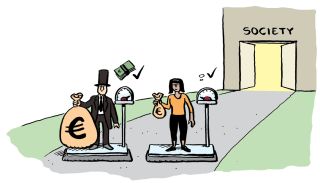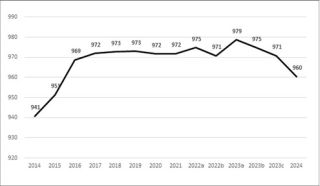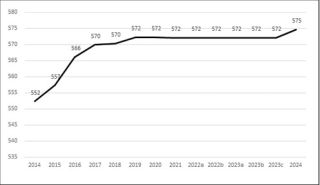Ireland’s Rich-Poor Gap & Middle-Poor Gap

As well as tracking the post-Budget income levels of different households (see p6-8 of our Budget 2024 Analysis and Critique | Social Justice Ireland), Social Justice Ireland is also focused on assessing how income divides in Irish society change following the adoption of Budgetary policies.
There is merit in undertaking this analysis for each Budget and also over multiple years so that the cumulative effects of Budgetary policies are captured. To achieve this, we track two measures, income gaps we plan to monitor and update annually. They provide a useful barometer of income divides in our society.
The Rich-Poor gap
This gap monitors the income of single individuals on jobseekers’ benefit (‘poor’) and the disposable income (after income taxation and employee social insurance) of a single PAYE worker earning €100,000 (‘rich’). The values of once-off cost of living supports are included. An annual income of €100,000 is chosen as representing very high income earners – it represents the top 6.5% of earners (180,000 earners) according to Revenue Commissioners data and is over twice average earnings.
As a result of all of the tax, welfare and one-off temporary measures adopted in Budget 2024, the rich-poor gap will decrease by €10 per week (€542 per annum) in 2024. The cumulative rich-poor gap will stand at €960 per week (€50,115 per annum) in 2024. The gap has decreased driven by the effect of the temporary cost of living measures in Budget 2024. It is of note that the combined effect of the emergency energy crisis measures in 2022-24 saw this gap fall for the first time over the last ten Budgets in 2022. However, these temporary measures are not currently scheduled to repeat in 2024 when the gap is likely to grow once again.
Table 1: The Rich-Poor and Middle-Poor Gap following Budget 2024
Rich: individual earner on €100,000 per annum | ||
Middle: individual earner on €40,000 per annum | ||
Poor: individual on jobseekers benefit | ||
| Rich-Poor Gap | Middle-Poor Gap |
Annual gap | €50,115 | €29,987 |
Gap per week | €960 | €575 |
Budget 2024 change in weekly gap | - €10.38 | + €2.59 |
Budget 2024 change in annual gap | - €541.88 | + €135.37 |
Chart 1: The Rich-Poor Gap, 2014-2024 (€ per week)

Notes: 2022a is the outcome from Budget 2022, 2022b is the outcome at the end of 2022, 2023a is the outcome from Budget 2023, 2023b is the outcome after including the additional supports announced in Feb. 2023, 2023c is the outcome at the end of 2023 including measures for 2023 in Budget 2024, 2024 are the planned measures for 2024.
The Middle-Poor gap
The middle-poor gap monitors the income of single individuals on jobseekers’ benefit (‘poor’) and the disposable income (after income taxation and employee social insurance) of a single PAYE worker earning €40,000 (‘middle’). This middle-income figure approximates the annual value of a worker working full-time and earning the median hourly level of earnings.
As a result of all the temporary and permanent measures adopted in Budget 2024, the middle-poor gap slightly grew. The cumulative middle-poor gap will be €575 per week (almost €30,000 per annum) next year. Overall, the middle-poor gap has grown by a total of €23 per week (€1,167 per annum) over the period 2014-2024.
Chart 2: The Middle-Poor Gap, 2014-2024 (€ per week)

Notes: 2022a is the outcome from Budget 2022, 2022b is the outcome at the end of 2022, 2023a is the outcome from Budget 2023, 2023b is the outcome after including the additional supports announced in Feb. 2023, 2023c is the outcome at the end of 2023 including measures for 2023 in Budget 2024, 2024 are the planned measures for 2024.